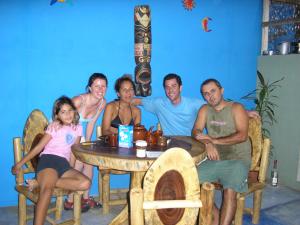The square boxes glared up at me from the application. Whether I realized it or not, a little piece of my fate was decided by which square got the ink.
I had resolved to spend my junior year abroad and had somehow convinced my parents it was a good idea to finance the journey. Now, filling out the application, it seemed that even the biggest decisions could be summarized in simple geometric shapes. Which housing situation did I prefer, shared apartments or homestay?
Having lived on my own for my first two years of college, homestay represented a regression to the confines of family life – lack of independence, family authority, stifled freedom. With negative expectations resonating through my mind, I chose against homestay for my year abroad in Spain.
My year was spent moving from one apartment to the next, consistently picking roommates classified as pathological. Although I escaped my unstable living situations unscathed (and with some pretty hilarious stories to boot), I couldn’t help but wonder if living with a family would have been a better option.

I got some insight into homestay during a trip to Costa Rica. Intercultura Language School in Sámara Beach had arranged my living situation for a five-day stint. I embarked on my first visit south of the border with nothing more than a name and address on a piece of paper, apprehensive of what I would be faced with as a living arrangement. I awkwardly arrived at my host’s front doorstep, over-packed, backpack in tow – greeted by a smiling, tan face in a bikini top.
It didn’t take me long to realize that my homestay parents were taking care of me in more ways than just giving a roof over my head and food to eat. Maricela took me on a hike to one of her favorite beaches, told me where to get the most delicious roasted chicken in town, drew maps of how to reach the best surf – 25 kilometers away by motorbike (one of my most memorable adventures to date). Her 10 year-old daughter and I gushed about Shakira, while her husband brought me to one of his favorite pizza places and shared stories about how Sámara was when there wasn’t a tourist in sight. Hours without end of conversation in Spanish pushed me to the limits of my language ability. Without a doubt, my homestay family shaped my five days into an incredible experience that allowed me to see past the tourist haze and into bona fide “tico” culture.

The Good, the Bad, the Roosters
There are two sides to every story. I got the scoop on negatives from a few students at the language school. Some cultural, religious and socio-economic differences may mean you have less independence and privacy than you are used to. More likely than not, the family schedule is a far cry from the nocturnal lifestyle of a student abroad. Their “early bird catches the worm” mantra may not sound so good when the rooster crows one hour after bedtime. It is expected that you let your family know if and when you won’t be around for meals. They may not be so quick to approve having your best guy or girl friend over, no matter how platonic you claim your relationship is.
After settling in, the benefits of homestay become clearer. Like many Americans living abroad soon discover, it’s not so easy to escape English when surrounded by English-speaking peers at your language school. Loriann Shwartz, a student at Intercultura, thought there would be more opportunities to speak Spanish while she was abroad. She confesses she is “tempted to just lay out all the time, and hang out with other foreigners from the school rather than Costa Ricans”. In her judgment, “living with a family is definitely worth it”, if only for the constant language practice and cultural exposure.
Laura Wellington, Founder and Director of Intercultura, likens the experience with having an adopted family. She says it gave her a “real connection with the culture” that transformed her experience. In fact, the ties she made through homestay are what inspired her to return to Costa Rica, and eventually establish the school. After staying in several countries with homestay living arrangements, she asserts that homestay is “about as important as the language program itself”.
Who’s it for and What to Look for
Homestay is a fantastic option for everyone, particularly students who are slightly introverted, or who are anxious about being away from their usual surroundings. Having a home-cooked meal and a family to come home to may make for a less stressful transition. Likewise, those attending shorter programs, would be ideal candidates for homestay because of accelerated assimilation into the foreign culture.
If you are interested in what homestay has to offer, consider the trademark traits of a good provider: good communication between students and staff, consistent host maintenance and flexible housing options.
Keep in mind the risk for a bad fit between a student and a homestay family comes with the territory. For this reason, it’s important to choose a program provider that has well-established communication between students and staff. For example, Intercultura has homestay family evaluations students fill out on a weekly basis. These frequent evaluations are trusted platforms to voice concerns to ensure any problematic situation is promptly taken care of. Families that consistently receive negative feedback are removed from the list of potential hosts. As one student suggests, what may seem like a picture-perfect situation, may change in a few weeks. It’s important to know your concerns or complaints will be addressed.
Before committing to a program, make sure you have options after you give it a good try. Should you be uncomfortable with your homestay situation (the road you live on is a bit too dark to walk home, the pet tarantula becomes your bed buddy and you don’t like it), check if you can change to another household. Let’s say you decide homestay is not your cup of tea after the first few weeks. Are there other living options available through your program, such as shared apartments or nearby cheap hotels? For year long programs, research options for living arrangements at the end of the first semester. You may be ready to try life on your own in a shared apartment.
Remember, there will be a period of adjustment before you feel truly comfortable in your new environment. Bring an open mind, become an observer and give it a fair shot. Choosing homestay could be the most culturally enriching aspect of your trip. Better yet, you may have some smiling faces and home-cooked grub to look forward to for future visits to your new second home.
Intercultura offers all levels of Spanish instruction on their beautiful campuses in Sámara Beach and Heredia, Costa Rica. Classes are small and personal, with a maximum of six people per class. Courses can be taken for university credit. For more inforamtion, email info@interculturacostarica.com or call U.S. toll free number (866) 363-5421.
Photos are by Deanna Wertheimer and Paul Robison.